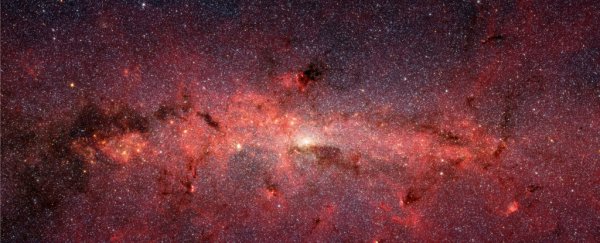Our search for extraterrestrial intelligence requires spanning distances so vast, sometimes it may feel even worse than finding a needle in a haystack.
Since the 1960s, astronomers have combed through billions of radio channels looking for anything out of the ordinary, as this could suggest not only some other form of life, but perhaps also advanced intelligence.
So far, it's been oddly quiet out there.
Breakthrough Listen (BL) is a relatively new astronomical program that looks for signs of alien technology in our local Universe (within about 160 light years from Earth). In its first three years, the team led by researchers from the University of California Berkeley has already achieved more than any other that's come before.
They've now opened up their data to the public before peer review, and the detailed analysis includes 1,327 nearby stars (nearly 80 percent of their local star sample) and consists of almost 1 petabyte of information, which is roughly 2,000 years-worth of music files.
Using radio and optical telescope observations from the Green Bank Radio Telescope (GBT) in West Virginia and CSIRO's Parkes Radio Telescope in Australia, the data set represents the most comprehensive and sensitive search for extraterrestrial life (SETI) in human history.
Still, after erasing millions of potential events that may have been caused by human interference or natural forces - for instance, bursts of cosmic radiation - there were only a handful of candidates left. Upon further analysis, the team was left completely empty-handed.
"This data release is a tremendous milestone for the Breakthrough Listen team," says lead author Danny Price.
"We scoured thousands of hours of observations of nearby stars, across billions of frequency channels. We found no evidence of artificial signals from beyond Earth, but this doesn't mean there isn't intelligent life out there: we may just not have looked in the right place yet, or peered deep enough to detect faint signals."
Searches like this are obviously limited by human understanding and imagination. These so-called alien technosignatures include only what we perceive as technology, and while yes, this includes things like radio signals, we are constantly adding more items to the list.
This is what astronomers refer to as a "pipeline", because it narrows and defines exactly what we are looking for, ultimately shrinking the size of the haystack like a cosmic rake.
Breakthrough's new paper has applied the most stringent limits to date, which means there is a chance that something we don't know about might have slipped through the cracks. Theoretically, though, it also gives us the greatest chance of finding that cosmic needle.
"Together with other recent work from the resurgent SETI community, we are beginning to put rigorous and clearly defined limits on the behaviour of advanced life in the Universe," the authors write in their new paper.
"We note that significant additional observational and theoretical work remains to be done before we are able to make general statements about the prevalence of technologically capable species."
Breakthrough's most recent SETI techniques are especially sensitive and include a rich variety of signal types, such as narrow-range radio frequencies and bright lasers that might be used for communication or propulsion technology.
To figure out whether the signal is indeed extraterrestrial and not just human radio interference, the scientists employed a "nodding" telescope technique. Choosing one target, the telescopes focus for five minutes (ON) and then turn towards a reference spot nearby for another five (OFF).
This 'ON-OFF' strategy is repeated three times, allowing the researchers to see whether a signal is coming from a fixed spot, or if it's showing up in other directions as well; the latter would indicate a higher chance of human interference. Additional methods, including machine learning, allowed the team to filter the signals out even further.
The analysis is an improvement on Breakthrough's previous results, published in 2017, which were not nearly as sensitive or as broad in their scope. Yet even when the 692 stars observed in this previous paper were included in the more detailed analysis, none of them proved to be worthy candidates for extraterrestrial life.
Giving up is not in the cards. The ten-year Breakthrough initiative is going to spend the remainder of its time finishing the multi-wavelength analysis of nearby stars and 100 nearby galaxies, while also expanding the search to higher frequencies and more signal types.
As if that's not enough, the team also hopes to conduct a radio survey of one million additional nearby stars, as well as radio and optical observations of the Galactic Plane and the Galactic Center.
"We haven't found anything in the data, but I'm certainly not giving up hope," Price told The Guardian.
"There are still so many more stars to look at and more search approaches to consider."
The research has been submitted to The Astrophysical Journal.
